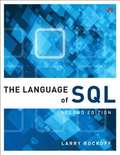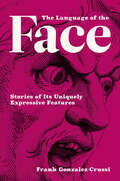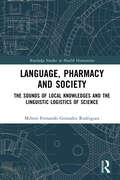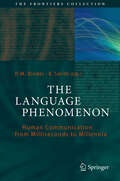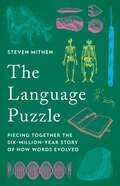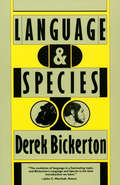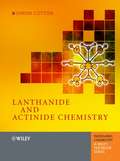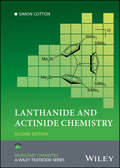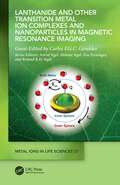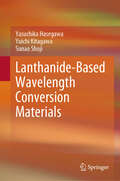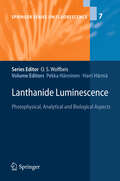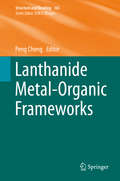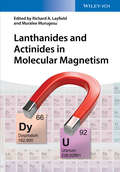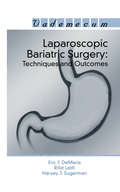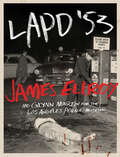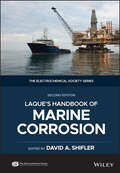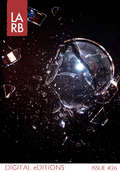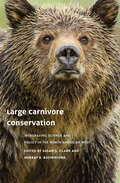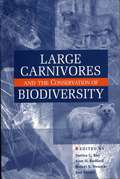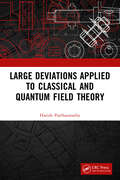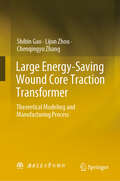- Table View
- List View
The Language of SQL (2nd Edition)
by Larry RockoffThe Language of SQL, Second Edition Many SQL texts attempt to serve as an encyclopedic reference on SQL syntax -- an approach that is often counterproductive, because that information is readily available in online references published by the major database vendors. For SQL beginners, it's more important for a book to focus on general concepts and to offer clear explanations and examples of what various SQL statements can accomplish. This is that book. A number of features make The Language of SQL unique among introductory SQL books. First, you will not be required to download software or sit with a computer as you read the text. The intent of this book is to provide examples of SQL usage that can be understood simply by reading. Second, topics are organized in an intuitive and logical sequence. SQL keywords are introduced one at a time, allowing you to grow your understanding as you encounter new terms and concepts. Finally, this book covers the syntax of three widely used databases: Microsoft SQL Server, MySQL, and Oracle. Special "Database Differences" sidebars clearly show you any differences in syntax among these three databases, and instructions are included on how to obtain and install free versions of the databases. This is the only book you need to gain a quick working knowledge of SQL and relational databases. Learn How To. . . Use SQL to retrieve data from relational databases Apply functions and calculations to data Group and summarize data in a variety of useful ways Use complex logic to retrieve only the data you need Update data and create new tables Design relational databases so that data retrieval is easy and intuitive Use spreadsheets to transform your data into meaningful displays Retrieve data from multiple tables via joins, subqueries, views, and set logic Create, modify, and execute stored procedures Install Microsoft SQL Server, MySQL, or Oracle Contents at a Glance 1 Relational Databases and SQL 2 Basic Data Retrieval 3 Calculated Fields and Aliases 4 Using Functions 5 Sorting Data 6 Selection Criteria 7 Boolean Logic 8 Conditional Logic 9 Summarizing Data 10 Subtotals and Crosstabs 11 Inner Joins 12 Outer Joins 13 Self Joins and Views 14 Subqueries 15 Set Logic 16 Stored Procedures and Parameters 17 Modifying Data 18 Maintaining Tables 19 Principles of Database Design 20 Strategies for Displaying Data A Getting Started with Microsoft SQL Server B Getting Started with MySQL C Getting Started with Oracle
The Language of the Face: Stories of Its Uniquely Expressive Features
by Frank Gonzalez-CrussiA broad and riveting cultural history of physiognomy, exploring how the desire to divine deeper meaning from our looks has compelled humans for millennia.How do you read a face? For thousands of years, artists, philosophers, and scientists have explored the question of what our outer appearance might reveal about our inner selves. In The Language of the Face, a marvelously comprehensive exploration of the pseudoscience of physiognomy, Frank Gonzalez-Crussi considers over a millennium&’s worth of primary sources to paint a splendid portrait of the face&’s cultural symbology. Gonzalez-Crussi, an acclaimed pathologist and writer, transcends disciplines with a singular balance of depth and levity. Blending literary analysis of both ancient and modern texts with the insights of medical anthropology, his narrative ranges from an investigation into &“nasal semiotics&”—a subject whose legacy persists most destructively in myths of racial typology—to equally astute analyses of the thrills of the erotic kiss, the diagnostic art of astrology, and the enlightening qualities of supposed ugliness. While our appearances may ultimately be no more than surface-level signifiers of identity, Gonzalez-Crussi&’s work is anything but superficial in its treatment of the consummately human urge to find profound meaning amidst seemingly arbitrary attributes. As rigorously researched as it is wildly entertaining, The Language of the Face is a vibrant contribution to both the emerging field of medical humanities and the popular understanding of aesthetics and physiology at large.
Language, Pharmacy and Society: The Sounds of Local Knowledges and the Linguistic Logistics of Science (Routledge Studies in Health Humanities)
by Milton Fernando RodriguezThis book explores the vital role language plays in shaping how we understand and discuss medicines, making for a more detailed study of pharmaceutical and pharmacological language to more clearly understand the intersection of language, health, and culture.Gonzalez Rodriguez charts the development of the language of pharmacy from the mid-19th century onward, drawing on data from Icelandic and Spanish natural language corpora, historical sources, and contemporary data. The book brings together scholarship from sociolinguistics, media, and cultural studies, and the history of science to highlight the possibilities afforded by an interdisciplinary approach to pharmacy-related language.The book will benefit readers by providing a deeper understanding of the intersection between language, science, and culture, making it especially valuable for students and scholars in sociolinguistics, history of science, medical humanities, and cultural studies.
The Language Phenomenon
by K. Smith P. M. BinderThis volume contains a contemporary, integrated description of the processes of language. These range from fast scales (fractions of a second) to slow ones (over a million years). The contributors, all experts in their fields, address language in the brain, production of sentences and dialogues, language learning, transmission and evolutionary processes that happen over centuries or millenia, the relation between language and genes, the origins of language, self-organization, and language competition and death. The book as a whole will help to show how processes at different scales affect each other, thus presenting language as a dynamic, complex and profoundly human phenomenon.
The Language Puzzle: Piecing Together the Six-Million-Year Story of How Words Evolved
by Steven MithenA top scholar reveals the most complete picture to date of how early human speech led to the languages we use today The emergence of language began with the apelike calls of our earliest ancestors. Today, the world is home to thousands of complex languages. Yet exactly how, when, and why this evolution occurred has been one of the most enduring—and contentiously debated—questions in science. In The Language Puzzle, renowned archaeologist Steven Mithen puts forward a groundbreaking new account of the origins of language. Scientists have gained new insights into the first humans of 2.8 million years ago, and how numerous species flourished but only one, Homo sapiens, survives today. Drawing from this work and synthesizing research across archaeology, psychology, linguistics, genetics, neuroscience, and more, Mithen details a step-by-step explanation of how our human ancestors transitioned from apelike calls to words, and from words to language as we use it today. He explores how language shaped our cognition and vice versa; how metaphor advanced Homo sapiens&’ ability to formulate abstract concepts, develop agriculture, and—ultimately—shape the world. The result is a master narrative that builds bridges between disciplines, stuns with its breadth and depth, and spans millennia of societal development. Deeply researched and brilliantly told, The Language Puzzle marks a seminal understanding of the evolution of language.
Language & Species
by Derek BickertonThe classic work on the origins and evolution of language from the pioneering linguist and author of Adam&’s Tongue.Language and Species presents the most detailed and well-documented scenario to date of the origins of language. Drawing on "living linguistic fossils" such as "ape talk," the "two-word" stage of small children, and pidgin languages—as well as important discoveries in paleoanthropology—Bickerton shows how a primitive "protolanguage" could have offered Homo erectus a novel ecological niche. He goes on to demonstrate how this protolanguage could have developed into the languages we speak today."You are drawn into [Bickerton's] appreciation of the dominant role language plays not only in what we say, but in what we think and, therefore, what we are."—Robert Wright, New York Times Book Review "The evolution of language is a fascinating topic, and Bickerton's Language and Species is the best introduction we have."—John C. Marshall, Nature
Language, Speech and Mind: Studies in Honour of Victoria A. Fromkin (Routledge Revivals)
by Charles N. Li Larry M. HymanFirst published in 1988, Language, Speech and Mind consists of 18 specially invited contributions to mark Professor Fromkin’s 65th birthday in 1988. It reflects her very special interdisciplinary interests and flair, thereby celebrating her own important contributions in the areas of phonetics, phonology, neurolinguistics, psycholinguistics, and the philosophy of science.
Lanthanide and Actinide Chemistry
by Simon CottonThe only introduction into the exciting chemistry of Lanthanides and Actinides. The book is based on a number of courses on "f elements" The author has a long experience in teaching this field of chemistry Lanthanides have become very common elements in research and technology applications; this book offers the basic knowledge The book offers insights into a vast range of applications, from lasers to synthesis The Inorganic Chemistry: A Textbook series reflects the pivotal role of modern inorganic and physical chemistry in a whole range of emerging areas, such as materials chemistry, green chemistry and bioinorganic chemistry, as well as providing a solid grounding in established areas such as solid state chemistry, coordination chemistry, main group chemistry and physical inorganic chemistry. Lanthanide and Actinide Chemistry is a one-volume account of the Lanthanides (including scandium and yttrium), the Actinides and the Transactinide elements, intended as an introductory treatment for undergraduate and postgraduate students. The principal features of these elements are set out in detail, enabling clear comparison and contrast with the Transition Elements and Main Group metals. The book covers the extraction of the elements from their ores and their purification, as well as the synthesis of the man-made elements; the properties of the elements and principal binary compounds; detailed accounts of their coordination chemistry and organometallic chemistry, from both preparative and structural viewpoints, with a clear explanation of the factors responsible for the adoption of particular coordination numbers; spectroscopy and magnetism, especially for the lanthanides, with case studies and accounts of applications in areas like magnetic resonance imaging, lasers and luminescence; nuclear separations and problems in waste disposal for the radioactive elements, particularly in the context of plutonium. Latest developments are covered in areas like the synthesis of the latest man-made elements, whilst there is a whole chapter on the application of lanthanide compounds in synthetic organic chemistry. End-of-chapter questions suitable for tutorial discussions are provided, whilst there is a very comprehensive bibliography providing ready access to further reading on all topics.
Lanthanide and Actinide Chemistry (Inorganic Chemistry: A Textbook Series)
by Simon CottonLANTHANIDE AND ACTINIDE CHEMISTRY Lanthanides and actinides, also known as “f elements,” are a group of metals which share certain important properties and aspects of electronic structure. They have a huge range of applications in the production of electronic devices, magnets, superconductors, fuel cells, sensors, and more. The cursory treatment of these important metals in most inorganic chemistry textbooks makes a book-length treatment essential. Since 2006, Lanthanide and Actinide Chemistry has met this need with a thorough, accessible overview. With in-depth accounts of the lanthanides, actinides, and transactinides, this book is ideal for both undergraduate and postgraduate students in inorganic chemistry or chemical engineering courses. Now updated to reflect groundbreaking recent research, this promises to continue as the essential introductory volume on the subject. Readers of the second edition of Lanthanide and Actinide Chemistry will also find: New and expanded subject areas including lanthanide enzymes, single-molecule magnets, luminescence and upconversion, organometallic and coordination chemistry; and many more. Up-to-date information on the myriad modern applications of f-elements Lists of objectives and learning goals at the start of each chapter Lanthanide and Actinide Chemistry is ideal for advanced undergraduates and graduate students in f-element chemistry, inorganic chemistry, or any related field. INORGANIC CHEMISTRY ADVANCED TEXTBOOK This series reflects the pivotal role of modern inorganic and physical chemistry in a whole range of emerging areas, such as materials chemistry, green chemistry and bioinorganic chemistry, as well as providing a solid grounding in established areas such as solid state chemistry, coordination chemistry, main group chemistry and physical inorganic chemistry.
Lanthanide and Other Transition Metal Ion Complexes and Nanoparticles in Magnetic Resonance Imaging (ISSN)
by Geraldes, Carlos F. G. C.Since the development of the first clinical MRI contrast agent, Gd(DTPA) (or Magnevist®) in the early 1980s, another three linear and three macrocyclic (eg. Gd(DOTA) (Dotarem®) have been introduced in the clinic and inspired a huge number of researchers worldwide to perform preclinical research to obtain contrast agents for many kinds of clinical applications, which are described in this book. The most current research has been assembled here and can be used by the scientific community to continue increasing the relevance of metal-containing molecules and nanomaterials for MRI-based diagnosis and thus increase the practical use of these systems. Presents the importance of metal-containing molecules and nanomaterials for MRI-based diagnosis and the practical use of these systems. Discusses the structure and dynamics of Ln-based contrast agents as well as computational studies related to these agents. Endorses and stimulates research in the vibrant field of biological inorganic chemistry. Reviews the most current research supporting the relevance of metal-containing molecules and nanomaterials for diagnosis and therapy. The authors are preeminent bioinorganic and medicinal inorganic chemists and review the most current research in this field.
Lanthanide-Based Wavelength Conversion Materials
by Yasuchika Hasegawa Yuichi Kitagawa Sunao ShojiThis book introduces optical wavelength conversion materials using luminescent lanthanide complexes. Their optical wavelength conversion properties are applied to color-tuning LED materials, UV photon-energy conversion for solar cells, and plant growth acceleration for future green-house application. In this book, the fundamental wavelength-conversion mechanism, recent trends and advanced research progress of optical wavelength conversion materials are explained and discussed using historical and recent academic reports. Furthermore, advanced future applications using luminescent lanthanide complexes, are introduced.
Lanthanide-Doped Luminescent Nanomaterials
by Xueyuan Chen Yongsheng Liu Datao TuLanthanide-Doped Luminescent Nanomaterials reviews the latest advances in the development of lanthanide-doped luminescent inorganic nanoparticles for potential bioapplications. This book covers the chemical and physical fundamentals of these nanoparticles, such as the controlled synthesis methodology, surface modification chemistry, optical physics, and their promising applications in diverse bioassays, with an emphasis on heterogeneous and homogeneous in-vitro biodetection of tumor biomarkers. This book is intended for those readers who are interested in systematically understanding the materials design strategy, optical behavior of lanthanide ions, and practical bioapplications of lanthanide nanoparticles. It primarily focuses on the interdisciplinary frontiers in chemistry, physics and biological aspects of luminescent nanomaterials. All chapters were written by scientists active in this field and for a broad audience, providing both beginners and advanced researchers with comprehensive information on the subject. Xueyuan Chen is a Professor at Fujian Institute of Research on the Structure of Matter (FJIRSM), Chinese Academy of Sciences. Yongsheng Liu is a Research Associate Professor at FJIRSM, Chinese Academy of Sciences. Datao Tu is a Research Assistant Professor at FJIRSM, Chinese Academy of Sciences.
Lanthanide Luminescence
by Pekka Hänninen Harri HärmäLanthanides have fascinated scientists for more than two centuries now, and since efficient separation techniques were established roughly 50 years ago, they have increasingly found their way into industrial exploitation and our everyday lives. Numerous applications are based on their unique luminescent properties, which are highlighted in this volume. It presents established knowledge about the photophysical basics, relevant lanthanide probes or materials, and describes instrumentation-related aspects including chemical and physical sensors. The uses of lanthanides in bioanalysis and medicine are outlined, such as assays for in vitro diagnostics and research. All chapters were compiled by renowned scientists with a broad audience in mind, providing both beginners in the field and advanced researchers with comprehensive information on on the given subject.
Lanthanide Metal-Organic Frameworks
by Peng ChengThe series Structure and Bonding publishes critical reviews on topics of research concerned with chemical structure and bonding. The scope of the series spans the entire Periodic Table and addresses structure and bonding issues associated with all of the elements. It also focuses attention on new and developing areas of modern structural and theoretical chemistry such as nanostructures, molecular electronics, designed molecular solids, surfaces, metal clusters and supramolecular structures. Physical and spectroscopic techniques used to determine, examine and model structures fall within the purview of Structure and Bonding to the extent that the focus is on the scientific results obtained and not on specialist information concerning the techniques themselves. Issues associated with the development of bonding models and generalizations that illuminate the reactivity pathways and rates of chemical processes are also relevant. The individual volumes in the series are thematic. The goal of each volume is to give the reader, whether at a university or in industry, a comprehensive overview of an area where new insights are emerging that are of interest to a larger scientific audience. Thus each review within the volume critically surveys one aspect of that topic and places it within the context of the volume as a whole. The most significant developments of the last 5 to 10 years should be presented using selected examples to illustrate the principles discussed. A description of the physical basis of the experimental techniques that have been used to provide the primary data may also be appropriate, if it has not been covered in detail elsewhere. The coverage need not be exhaustive in data, but should rather be conceptual, concentrating on the new principles being developed that will allow the reader, who is not a specialist in the area covered, to understand the data presented. Discussion of possible future research directions in the area is welcomed. Review articles for the individual volumes are invited by the volume editors. Readership: research scientists at universities or in industry, graduate students.
Lanthanide Single Molecule Magnets
by Jinkui Tang Peng ZhangThis book begins by providing basic information on single-molecule magnets (SMMs), covering the magnetism of lanthanide, the characterization and relaxation dynamics of SMMs and advanced means of studying lanthanide SMMs. It then systematically introduces lanthanide SMMs ranging from mononuclear and dinuclear to polynuclear complexes, classifying them and highlighting those SMMs with high barrier and blocking temperatures - an approach that provides some very valuable indicators for the structural features needed to optimize the contribution of an Ising type spin to a molecular magnet. The final chapter presents some of the newest developments in the lanthanide SMM field, such as the design of multifunctional and stimuli-responsive magnetic materials as well as the anchoring and organization of the SMMs on surfaces. In addition, the crystal structure and magnetic data are clearly presented with a wealth of illustrations in each chapter, helping newcomers and experts alike to better grasp ongoing trends and explore new directions. Jinkui Tang is a professor at Changchun Institute of Applied Chemistry, Chinese Academy of Sciences. Peng Zhang is currently pursuing his PhD at Changchun Institute of Applied Chemistry, Chinese Academy of Sciences, with a specific focus on the molecular magnetism of lanthanide compounds under the supervision of Prof. Jinkui Tang.
Lanthanides and Actinides in Molecular Magnetism
by Muralee Murugesu Richard LayfieldThe first reference on this rapidly growing topic provides an essential up-to-date guide to current and emerging trends.A group of international experts has been carefully selected by the editors to cover all the central aspects, with a focus on molecular species while also including industrial applications.The resulting unique overview is a must-have for researchers, both in academia and industry, who are entering or already working in the field.
Laparoscopic Bariatric Surgery: Techniques and Outcomes
by Eric J. DeMariaThere is no more technically demanding laparoscopic procedure than laparoscopic proximal gastric bypass. Furthermore, training and skill in advanced laparoscopy are inadequate background for developing a program since the bariatric patient presents many complex issues in management for the surgeon. Thus, the novice must master the skills of two disciplines: advanced laparoscopy and bariatric surgical care. The authors bring forward their significant experience in bariatric surgery and lessons learned from the development of their laparoscopic obesity surgery program in order to provide a resource to surgeons committed to bringing safe and effective laparoscopic treatment to their morbidly obese patients.
LAPD '53
by James Ellroy Glynn MartinA remarkable portrait of &“true L.A. noir&” with archival photos from the Los Angeles Police Museum and text by legendary crime writer James Ellroy (Los Angeles Times). James Ellroy, the undisputed master of crime writing, has teamed up with the Los Angeles Police Museum to present a stunning text on 1953 L.A. While combing the museum&’s photo archives, Ellroy discovered that the year featured a wide array of stark and unusual imagery—and to accompany the pictures, he has written text to illuminate the crimes and law enforcement of the era. Ellroy offers context along with wild detail and rich atmosphere—this is the cauldron that was police work in the city of the tarnished angels seven decades ago, revealed in more than 80 duotone photos throughout the book. &“These crime images resemble the work of photographer Weegee, but, Ellroy argues, they&’re superior because they resist artistry; they were taken by police officers doing their jobs.&” —Chicago Tribune
LaQue's Handbook of Marine Corrosion (The ECS Series of Texts and Monographs)
by David A. ShiflerThe new edition of LaQue's classic text on marine corrosion, providing fully updated control engineering practices and applications Extensively updated throughout, the second edition of La Que's Handbook of Marine Corrosion remains the standard single-source reference on the unique nature of seawater as a corrosive environment. Designed to help readers reduce operational and life cycle costs for materials in marine environments, this authoritative resource provides clear guidance on design, materials selection, and implementation of corrosion control engineering practices for materials in atmospheric, immersion, or wetted marine environments. Completely rewritten for the 21st century, this new edition reflects current environmental regulations, best practices, materials, and processes, with special emphasis placed on the engineering, behavior, and practical applications of materials. Divided into three parts, the book first explains the fundamentals of corrosion in marine environments, including atmospheric corrosion, erosion, microbiological corrosion, fatigue, environmental cracking, and cathodic delamination. The second part discusses corrosion control methods and materials selection that can mitigate or eliminate corrosion in different marine environments. The third section provides the reader with specific applications of corrosion engineering to structures, systems, or components that exist in marine environments. This much-needed new edition: Presents a comprehensive and up-to-date account of the science and engineering aspects of marine corrosion Focuses on engineering aspects, descriptive behavior, and practical applications of materials usage in marine environments Addresses the various materials used in marine environments, including metals, polymers, alloys, coatings, and composites Incorporates current regulations, standards, and recommended practices of numerous organizations such as ASTM International, the US Navy, the American Bureau of Shipping, the International Organization for Standardization, and the International Maritime Organization Written in a clear and understandable style, La Que's Handbook of Marine Corrosion, Second Edition is an indispensable resource for engineers and materials scientists in disciplines spanning the naval, maritime, commercial, shipping industries, particularly corrosion engineers, ship designers, naval architects, marine engineers, oceanographers, and other professionals involved with products that operate in marine environments.
LARB Digital Edition: A Legible Science
by Los Angeles Review of BooksWe're all prone to excess, even in discussions of excess, observes biologist and science writer Marlene Zuk. This year has been marked by another rainfall of books about humans destroying the environment in which they evolved, a few about the a priori Darwinian mismatch between humans and their so-called "natural" environments, and a great many more about the even greater mismatch between humans and their constructed environments. This month's Digital Edition gathers some of the best essays and reviews from LARB's Science Section that deal with aspects of the mismatch, and how scientific discoveries and agendas are changing how we think about them. Several also deal with issues of legibility -- how science goes about making legible human experience, not to mention environmental impacts. From the exploding fields of neuroscience and genetics to reading the movement of glaciers, this month's selection of articles is the perfect match for readers in search of a legible science.
Large Camel Farming: A Care-Management Guide from Breeding to Camel Products
by Bernard Faye Gaukhar Konuspayeva Cécile MagnanThis practical guide is intended for all actors in the sector who work with large camelids, whether in breeding, technical advice or veterinary care. It successively describes the general aspects of the species, the physiological bases of reproduction, lactation and feeding, the main production processes, and health and hygiene management in camel breeding. Chapters on slaughter, important camel products and their processing complete the volume.Large camels (camels and Bactrian camels) are domestic animals that are increasingly used in Western countries, as well as in Africa and Asia, for tourism, sport, and production of milk, meat, and wool. In addition, camel husbandry systems are changing, taking a greater share of sedentary systems, specializing in breeding, and intensifying production. At the same time, many veterinarians and breeders are not familiar with the animal, its needs, physiology, diseases, and management, which is often based on practices introduced for cattle and proving ineffective.This work is a practical aid for all interested readers who want to embark on the adventure of working with large camelids in a cultural context where they are not yet a dominant element of the agricultural landscape. The numerous photographs and drawings that support the text make it a unique and entertaining read.
Large Carnivore Conservation: Integrating Science and Policy in the North American West
by David J. Mattson Rebecca Watters Avery C. Anderson Susan G. Clark Douglas Clark Linaya Workman D. Scott Slocombe William M. Pym Micheal L. Gibeau Seth M. Wilson Gregory A. Neudecker James J. Jonkel J. Daniel Oppenheimer Lauren Richie David N. Cherney Christina MilloyStrategies for protecting wolves, mountain lions, and more—by taking the human species into account as well: &“Very valuable.&”—Journal of Wildlife Management Drawing on six case studies of wolf, grizzly bear, and mountain lion conservation in habitats stretching from the Yukon to Arizona, Large Carnivore Conservation argues that conserving and coexisting with large carnivores is as much a problem of people and governance—of reconciling diverse and sometimes conflicting values, perspectives, and organizations, and of effective decision making in the public sphere—as it is a problem of animal ecology and behavior. By adopting an integrative approach, editors Susan G. Clark and Murray B. Rutherford seek to examine and understand the interrelated development of conservation science, law, and policy, as well as how these forces play out in courts, other public institutions, and the field. In combining real-world examples with discussions of conservation and policy theory, Large Carnivore Conservation not only explains how traditional management approaches have failed to meet the needs of all parties, but also highlights examples of innovative, successful strategies and provides practical recommendations for improving future conservation efforts. &“Building on decades of work, this book integrates biological knowledge with human dimensions study and charts a course for coexistence with large carnivores.&”—Douglas W. Smith, Senior Wildlife Biologist, Yellowstone National Park
Large Carnivores and the Conservation of Biodiversity
by Joel Berger Justina Ray Robert Steneck Kent H. RedfordLarge Carnivores and the Conservation of Biodiversity brings together more than thirty leading scientists and conservation practitioners to consider a key question in environmental conservation: Is the conservation of large carnivores in ecosystems that evolved with their presence equivalent to the conservation of biological diversity within those systems? Building their discussions from empirical, long-term data sets, contributors including James A. Estes, David S. Maehr, Tim McClanahan, AndrFs J. Novaro, John Terborgh, and Rosie Woodroffe explore a variety of issues surrounding the link between predation and biodiversity: What is the evidence for or against the link? Is it stronger in marine systems? What are the implications for conservation strategies? Large Carnivores and the Conservation of Biodiversity is the first detailed, broad-scale examination of the empirical evidence regarding the role of large carnivores in biodiversity conservation in both marine and terrestrial ecosystems. It contributes to a much more precise and global understanding of when, where, and whether protecting and restoring top predators will directly contribute to the conservation of biodiversity. Everyone concerned with ecology, biodiversity, or large carnivores will find this volume a unique and thought-provoking analysis and synthesis.
Large Deviations Applied to Classical and Quantum Field Theory
by Harish ParthasarathyThis book deals with a variety of problems in Physics and Engineering where the large deviation principle of probability finds application. Large deviations is a branch of probability theory dealing with approximate computation of the probabilities of rare events. It contains applications of the LDP to pattern recognition problems like analysis of the performance of the EM algorithm for optimal parameter estimation in the presence of weak noise, analysis and control of non-Abelian gauge fields in the presence of noise, and quantum gravity wherein we are concerned with perturbation to the quadratic component of the Einstein-Hilbert Hamiltonian caused by higher order nonlinear terms in the position fields and their effect on the Gibbs statistics and consequently quantum probabilities of events computed using the quantum Gibbs state. The reader will also find in this book applications of LDP to quantum filtering theory as developed by Belavkin based on the celebrated Hudson-Parthasarathy quantum stochastic calculus. Print edition not for sale in South Asia (India, Sri Lanka, Nepal, Bangladesh, Pakistan and Bhutan).
Large Energy-Saving Wound Core Traction Transformer: Theoretical Modeling and Manufacturing Process
by Shibin Gao Lijun Zhou Chenqingyu ZhangThis book delves into the innovative realm of wound core transformers designed for high-voltage power grids, moving beyond the traditional laminated core structures prone to magnetic flux leakage and energy dissipation. Through a novel enclosed wound core design that eliminates joints and corners, it presents a transformative approach that minimizes leakage and enhances the electromagnetic performance of transformers. This book not only addresses the technical challenges and solutions in transformer design but also marks a significant step forward in the pursuit of energy efficiency and performance optimization in electrical power systems. Targeting a specialized audience of professors, scholars, and graduate students engaged in transformer energy-saving optimization and related research fields, it offers an in-depth exploration of the complete loss calculation, innovative manufacturing processes, and testing technologies of large-scale wound core transformers.
